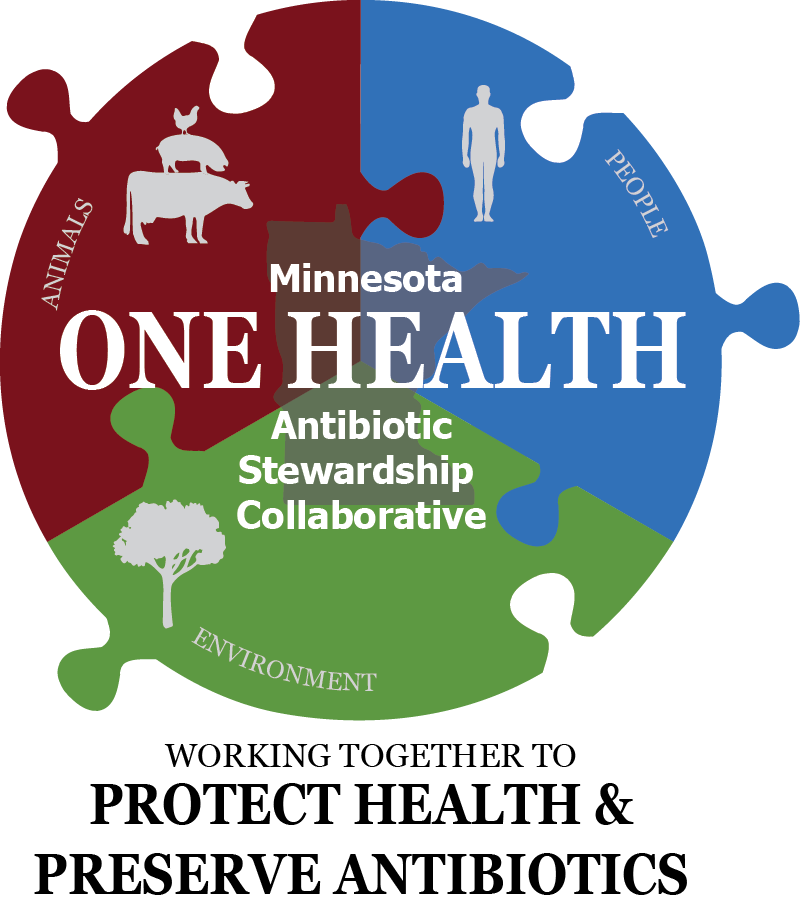Minnesota Department of Health MN Antibiotic Stewardship Collaborative Update Bulletin
Minnesota Department of Health sent this bulletin at 02/17/2017 08:59 AM CST |
Updates and News Alerts from the Minnesota One Health Antibiotic Stewardship Collaborative |
Stewardship quiz? You betcha! (scroll down for answer)
In Minnesota's 2015 invasive Staphylococcus aureus surveillance, what percentage of methicillin-resistant S. aureus (MRSA) cases were healthcare-associated, community onset (HACO), community-associated (CA), and hospital-onset (HO)?
a. HACO 51%, CA 22%, HO 27%
b. HACO 72%, CA 18%, HO 10%
c. HACO 91%, CA 6%, HO 3%
d. HACO 32%, CA 36%, HO 32%
Update from Your Minnesota Stewardship Collaborative
We Want to Hear from You!
Minnesota One Health Antibiotic Stewardship Collaborative members are hard at work to carry out Strategic Plan objectives. Hearing about your experiences with antibiotic stewardship programs, antibiotic-resistant infections, and communicating with patients and clients is helpful to us. Feel free to let us know about your stewardship challenges and successes in human, animal, and environmental health. health.stewardship@state.mn.us
News to Note
Final Report of the AVMA Task Force on Antimicrobial Stewardship in Companion Animal Practice Released.
- The report includes suggested "core elements" of companion animal stewardship, modeled after the Centers for Disease Control and Prevention (CDC) core elements for stewardship in various health care settings.
European CDC Report Reveals "Worrying" Increase in Gram-negative Resistance.
- During 2012–2015, there was a significant increase in resistance to third-generation cephalosporins in Escherichia coli and Klebsiella pneumoniae across the surveillance countries.
- Extended-spectrum beta-lactamase (ESBL) production was associated with a large proportion of the bacteria resistant to third-generation cephalosporins.
- Resistance of E. coli and K. pneumoniae to third-generation cephalosporins was also increasingly seen in combination with aminoglycoside and fluoroquinolone resistance.
New Paper Describes Antibiotic Prescribing by General Dentists in the United States.
- By using a proprietary all-payers prescription database, authors described dental prescribing of oral antibiotics during 2013.
- Overall, general dentists prescribed 77.5 prescriptions per 1,000 people, with the highest prescription rate for persons aged 40-64 years (103.6/1,000).
- Penicillin family drugs were most commonly prescribed, which is consistent with current guidelines. However, some drug categories generally not indicated in dentistry were also prescribed, which the authors identify as an opportunity for improvement.
Upcoming Events
2017 Minnesota Antibiotic Stewardship Conference: Focus on Long-Term Care
- March 15, 2017; 8am-4:30pm; Saint Paul, MN.
- Continuing education conference hosted by Stratis Health and Minnesota Department of Health.
- Antibiotic stewardship teams from long-term care encouraged to register.
- Click here to register for this free conference.
Minnesota Veterinary Medical Association Annual Meeting
- February 23-25, 2017; Minneapolis, MN
Quiz Answer!
Correct Answer: b. HACO 72%, CA 18%, HO 10%
Invasive methicillin-resistant Staphylococcus aureus (MRSA) infections are classified into three categories: hospital-onset (HO-MRSA), healthcare-associated, community-onset (HACO-MRSA), and community-associated (CA-MRSA). S. aureus must be isolated from a normally sterile body site >3 days after hospital admission to be HO, have at least one healthcare risk factor in the year prior to infection to be HACO, and have no healthcare risk factors in the last year to be CA. Examples of healthcare risk factors include residence in a long term care facility, recent hospitalization(s), dialysis, presence of an indwelling central venous catheter, and surgery. CA cases do not have any identifiable HA risk factors present in the year prior to infection.
Surveillance for invasive MRSA occurs in Hennepin and Ramsey Counties. The incidence rate decreased to 11.2 per 100,000 in 2015 (Ramsey: 10.3/100,000, Hennepin: 11.6/100,000) compared to 15.2/100,000 population in 2014. In 2015, MRSA was most frequently isolated from blood (77%), and 13% (25/196) of cases died in the hospital.
Vancomycin-intermediate (VISA) and vancomycin-resistant S. aureus (VRSA) are reportable in Minnesota. During 2008-2013, Minnesota Department of Health confirmed 16 VISA cases, but none in 2014 or 2015.There have been no VRSA cases in Minnesota.
Learn more about 2015 invasive S. aureus surveillance on Minnesota Department of Health's website.
Handy Links
Minnesota One Health Collaborative
CIDRAP: Antimicrobial Stewardship
USDA: Antimicrobial Resistance
Having trouble viewing this email? View it as a Web page.
